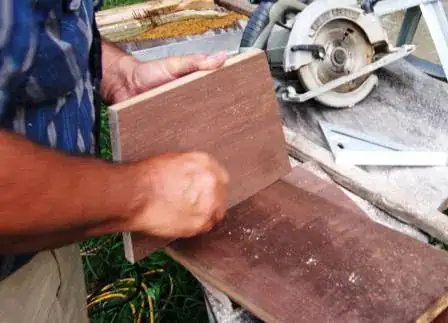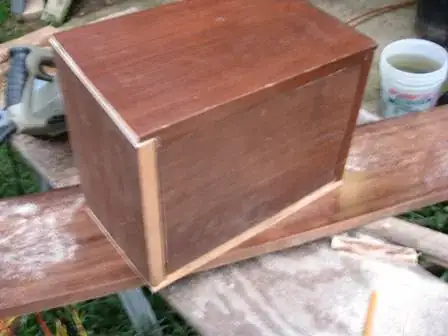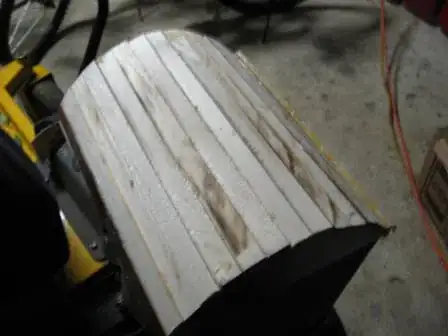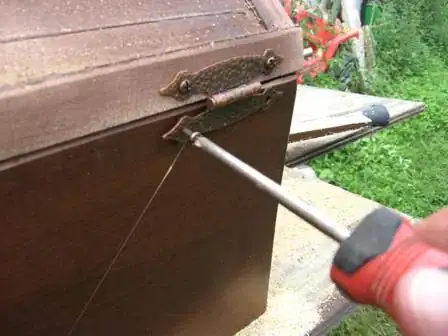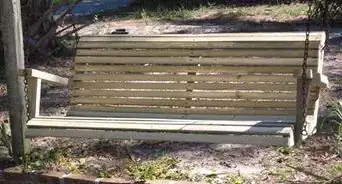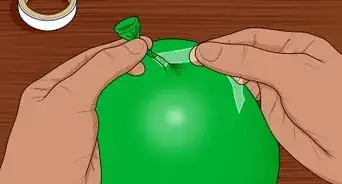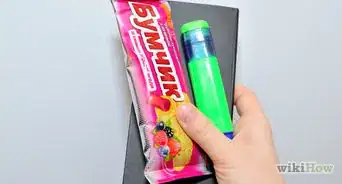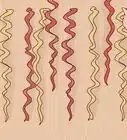X
wikiHow is a “wiki,” similar to Wikipedia, which means that many of our articles are co-written by multiple authors. To create this article, 28 people, some anonymous, worked to edit and improve it over time.
This article has been viewed 413,549 times.
Learn more...
Whether for the little pirate, or for your own safe storage, a simple wooden treasure chest can be built in an afternoon with some common tools and inexpensive lumber. Here are some steps to show you how it's done.
Steps
-
1Plan the size of your chest. The one built in this project is 11 inches wide, 9 inches tall (excluding the top) and 16 inches long (28 x 23 x 41 cm).
-
2Gather the lumber you will use. Here, we used 1 X 10 (19 mm × 235 mm) scrap maple lumber which had been stained and lacquered, then thrown in a construction site dumpster. For the size in the illustrations, an eight foot (2.4 m) long board and some odd scraps were used.Advertisement
-
3Set up a table to do the assembly on. Two saw horses and a sheet of plywood works fine, but a heavy workbench would be better.
-
4Get the tools out, making sure the circular saw has a sharp blade. There are some rabbets to cut for joining the corners, and a sharp blade will make this process much easier.[1]
-
5Mark your lumber for the cuts. Here, the end pieces are cut 8 3/8 inches (21.3 cm), to the short point, with each end cut on a 7 degree angle so the sides of the chest will be slanted. Mark each cut on one piece of lumber, then cut them carefully. Use the first piece as a pattern to cut the second, or measure and mark it exactly, if you prefer.[2]
-
6Cut your side boards, making each cut square (a 90 degree angle). Make sure one end of the board is square, then measure 16 inches (40.6 cm). Make your mark, then scribe a straight line across the board using a framing square. Cut these carefully, as well.
-
7Mark the rabbet cuts for the side boards to join the ends. You can use the end boards to scribe the cuts as shown in the photo, or measure 3/4 of an inch (1.9 cm) and square this line. Cut 2/3 of the thickness of the lumber deep. Here, we are using a nominal one by board, 3/4 inch (1.9 cm) thick, so we set the saw to cut 1/2 inch (1.25 cm) deep.
-
8Set the board on end , holding it in a vise or clamped to the work table, and cut 3/4 of an inch (1.9 cm) deep across the end, 1/2 of an inch (1.25 cm) back from the finished side.
-
9Join the end boards to the side boards. We used a carpenter's grade hot melt wood glue, but these joints may be nailed or screwed, or fastened with conventional wood glue. Make sure all edges are flush and true, and try to keep the corners as square as possible. A jig will help if you are having difficulty aligning and squaring the pieces.[3]
-
10Measure the opening at the bottom of your box. Using the dimensions of the chest shown, the bottom will be 14 1/2 inches (36.8 cm) by 7 inches (17.8 cm), but checking the actual assembled size will provide a better fit. Cut the bottom out of a piece of your lumber, the size you have measured, with the saw blade set on a 7 degree bevel on the long sides so it fits the tapered sides of your chest.
-
11Install the bottom into your box. If it is cut correctly, you may need to tap it into place, since the tapered edges will seat firmly into the bottom.
-
12Lay the box on its edge, and mark a line 3/8 of an inch (.95 cm) below the top, and cut around the box, 3/8 inch deep. Cut 3/8 inch deep around the top of the box, 3/8 inch from the outside edge. This will form a recess for the lid to set down on, creating a somewhat better seat for the lid to set in
-
13Mark two pieces of lumber the width of the chest long, here, 10 1/4 inches (26 cm). If you are using wide lumber, as in the photos, you can rip it in half to reduce waste. Mark a radius from the edge to form the curved shape of the top of the chest. Here, we used the lid from a five gallon bucket, which provided an ideal curve with little effort.
-
14Cut the radius on the first piece, using a jigsaw or coping saw, then mark the second, using the first as a pattern. These two pieces should be as closely matched as possible to make fitting the finished lid easier.
-
15Cut a rabbet, 3/8 inch (.95 cm) wide and deep in the bottom of the lid ends. Here, a vise or clamp is very helpful, since the stock you are cutting is almost impossible to hold safely while you cut. When the two ends are cut and rabbeted, you can temporarily attach them to the chest to make fitting the lid slats more simple. Here, again, hot melt glue makes this quick and simple.
-
16Rip strips of lumber 1/4 inch (.6 cm) thick. Make sure they are at least as long as the length of the chest, but ripping longer boards and then cutting several to length from each rip will save time.
-
17Cut the strips the same length as the sides of your chest. If you have attached the lid ends to the top of the chest box, you can simply scribe them in place. Glue these, starting on each side and the center of the top, to keep the assembly square and true. Fit the edges as tightly as possible, but because of the radius of the lid, you can expect a noticeable gap unless you choose to bevel each piece individually. You can leave these strips overhanging each end slightly by cutting them 1/4 inch (.6 cm) long, then after attaching them, the ends can be sanded flush.
-
18Attach enough strips to wrap the lid, forming a complete cover, then add an additional strip on the front and rear edges to attach hardware to. Clean up the edges, light sand the surfaces, and bevel corners and other features that may produce splinters or leave a sharp edge.[4]
-
19Rip two very thin strips to overlay on the lid ends. These will act as bands, and help secure the lid slats to the box, but for all practical purposes, they are ornamental. Test fit these strips and scribe the ends, then cut them to length. Make sure they are sufficiently thin and limber to bend the radius of your lid without splitting or cracking. Attach them with glue or tacks.
-
20Sand all the corners and edges of your chest and lid. If you want to stain or paint the chest, now is the time to do it, before the hardware (hinges, handles, and the hasp) is installed.
-
21Finish the wood, depending on your preference. Since this project was started with stained hardwood, and no matching stain was available, brown spray paint was used to blend the colors of the original stain, giving a pretty good finish.
-
22Attach the hardware. Here, antiqued cabinet hinges and pull handles were used to add to the rustic effect. The hardware can be attached with the Hot Melt glue so it can be test fitted, or you can simply attach it with the screws provided in the set you buy. Be sure to check the operation of hinges before completing installation, since if they are not correctly aligned, they will likely bind or cause the lid to fit crookedly.[5]
Advertisement
Community Q&A
-
QuestionWhat would be the approximate costs?
 Ashton GilmoreCommunity AnswerThis article shows scrap wood being used. Assuming you have the proper tools, you would only have to buy hardware such as handles, latches, and hinges. I would estimate the hardware at ~$5 at your hardware store.
Ashton GilmoreCommunity AnswerThis article shows scrap wood being used. Assuming you have the proper tools, you would only have to buy hardware such as handles, latches, and hinges. I would estimate the hardware at ~$5 at your hardware store.
Advertisement
Things You'll Need
- Power tools
- Work table
- Lumber, as described in steps
- Fasteners or glue
- Measuring and squaring tools
- Sander (optional)
References
- ↑ https://www.woodmagazine.com/woodworking-tips/techniques/joinery/5-ways-to-make-precision-rabbet-cuts
- ↑ https://ibuildit.ca/projects/scrap-wood-treasure-box/
- ↑ https://www.youtube.com/watch?v=Sy02SEOXTfw
- ↑ https://www.youtube.com/watch?v=qof4MvLSsYM
- ↑ https://www.smithdtyler.com/2019/06/how-to-build-simple-treasure-chest.html
About This Article
Advertisement
